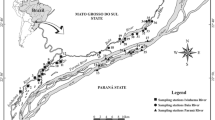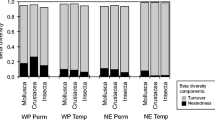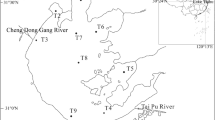Abstract.
Assessments of biodiversity are time-consuming and require a high level of expert knowledge. A reduced set of taxonomic ranks other than species has been proved to be useful for rapid and cost-effective assessment of biodiversity. However, few studies have examined how well this method performs for aquatic plant group that of enormous ecological importance. We studied the aquatic plant flora in the arid zone of China and examined whether the distribution of species α- and β-diversity could be predicted well from genus-, and family-levels. Analyses of 3 years field data showed that significant and positive relations exist between α-diversity of species and α-diversity of genera and family in both entire arid zone and five sub-zones. In contrast, β-diversity at species level is difficult to predict from β-diversity indexes at higher taxonomic level. The results indicate that higher-taxon α-diversity, especially at the generic level in our research, can be useful surrogates of species α-diversity for aquatic plants conservation.
Similar content being viewed by others
References
A.L. Andersen (1995) ArticleTitleMeasuring more of biodiversity: genus richness as a surrogate for species richness in Australian ant faunas Biol. Conserv. 73 39–43 Occurrence Handle10.1016/0006-3207(95)90059-4
InstitutionalAuthorNameAnonymous (1985) Nature Geography of China (Pandect) Science Press Beijing 363–394
A. Balmford M.J.B. Green M.G. Murray (1996) ArticleTitleUsing higher-taxon richness as a surrogate for species richness: I. Regional tests Proc. R. Soc. Lond. Ser. B. 263 1267–1274 Occurrence Handle10.1098/rspb.1996.0186
A. Balmford A.J.E. Lyon R.M. Lang (2000) ArticleTitleTesting the higher-taxon approach to conservation planning in a megadiverse group: the macrofungi Biol. Conserv. 93 209–217 Occurrence Handle10.1016/S0006-3207(99)00140-8
C.D.K. Cook (1985) ArticleTitleRange extensions of aquatic vascular plant species J. aquat. plant manage. 23 1–6
Cook C.D.K. 1990. Aquatic Plant Book. SPB Academic Publishing.
D.P. Faith P.A. Walker (1996) ArticleTitleHow do indicator groups provide information about the relative biodiversity of different sets of areas? On hotspots, complementarity and pattern based approaches Biodiv. Lett. 3 18–25 Occurrence Handle10.2307/2999706
K.J. Gaston P.H. Williams (1993) ArticleTitleMapping the world’s species – the higher taxon approach Biodiv. Lett. 1 2–8 Occurrence Handle10.2307/2999642
K.J. Gaston (2000) ArticleTitleGlobal patterns in biodiversity Nature 405 220–227 Occurrence Handle10821282 Occurrence Handle10.1038/35012228 Occurrence Handle1:CAS:528:DC%2BD3cXjsFyjs7o%3D
C.E.V. Grelle (2002) ArticleTitleIs higher-taxon analysis an useful surrogate of species richness in studies of neotropical mammal diversity? Biol. Conserv. 108 101–106 Occurrence Handle10.1016/S0006-3207(02)00094-0
C.J. Krebs (1999) Ecological Methodology Benjamin/Cummings Menlo Park
A.E. Magurran (1988) Ecological Diversity and its Measurement Princeton University Press NJ
D. Mckee K. Hatton J.W. Eaton D. Atkinson A. Atherton I. Harvey B. Moss (2002) ArticleTitleEffects of simulated climate warming on macrophytes in freshwater microcosm communities Aquat. Bot. 74 71–83 Occurrence Handle10.1016/S0304-3770(02)00048-7
J. McNeely K. Miller W. Reid R. Mittermeier T. Werner (1990) Conserving the World’s Biological Diversity IUCN Gland
R.M. Nally E. Fleishman L.P. Bulluck C.J. Betrus (2004) ArticleTitleComparative influence of spatial scale on beta diversity with regional assemblages of brids and butterflies J. Biogeogr. 31 917–929 Occurrence Handle10.1111/j.1365-2699.2004.01089.x
H.R. Negi M. Gadgil (2002) ArticleTitleCross-taxon surrogacy of biodiversity in the Indian Garhwal Himalaya Biol. Conserv. 105 143–155 Occurrence Handle10.1016/S0006-3207(01)00158-6
G.T. Prance (1994) ArticleTitleA comparison of the efficacy of higher taxa and species numbers in the assessment of bio-diversity in the neotropics Phil. Trans. R. Soc. Lond. 345 IssueIDB 89–99 Occurrence Handle10.1098/rstb.1994.0090
A. Prinzing S. Klotz J. Stadler R. Brandl (2003) ArticleTitleWoody plants in Kenya: expanding the higher-taxon approach Biol. Conserv. 110 307–314 Occurrence Handle10.1016/S0006-3207(02)00242-2
D.L. Saunders J.J. Meeuwig A.C.J. Vincent (2002) ArticleTitleFreshwater protected areas: strategies for conservation Conserv. Biol. 16 30–41 Occurrence Handle10.1046/j.1523-1739.2002.99562.x
Q.C. Tang Y.G. Qu Z.C. Zhou (1992) Hydrology and Water Resource Utilization of Arid Region in China Science Press Beijing
InstitutionalAuthorNameUNEP (1992) Convention on Biological Diversity UNEP Nairobi
M.A. Vanderklift T.J. Ward J.C. Phillips (1998) ArticleTitleUse of assemblages derived from different taxonomic levels to select areas for conserving marine biodiversity Biol. Conserv. 86 307–315 Occurrence Handle10.1016/S0006-3207(98)00036-6
D. Wang D. Yu Z.Y. Li (2002) ArticleTitle Myriophllum exasperatum (Haloragacaea) a new species from China Ann. Bot. Fennici 39 267–271
P.H. Williams K.J. Gaston (1994) ArticleTitleMeasuring more of biodiversity: can higher-taxon richness predict wholesale species richness? Biol. Conserv. 67 211–217 Occurrence Handle10.1016/0006-3207(94)90612-2
D. Yu D. Wang Z.Q. Li (2001) ArticleTitleTwo species of the genus Myriophllum L. (Haloragacaea) new recorded in China Acta Phytotaxon. Sinica 39 575–578
D. Yu Z.Q. Li D. Wang S.L. Xia (2002a) ArticleTitle Subularia L. (Cruciferae), a newly recorded aquatic genus of China Acta Phytotaxon. Sinica 40 458–459
D. Yu D. Wang Z.Y. Li (2002b) ArticleTitleTaxonomic revision of the genus Myriophllum (Haloragacaea) in China Rhodora 104 396–421
D. Yu D. Wang Z.Q. Li Z.Y. Li (2002c) ArticleTitleThe discovery of Myriophllum oguraenseMiki (Haloragacaea) in China Acta Phytotaxon. Geobot. 53 201–204
Z.K. Zhang D.Y. Yang (2001) ArticleTitleLake water resources – environmental Problems and its measures in the arid regions of Northwest China J. Arid Land Res. Environ. 15 7–10 Occurrence Handle1:CAS:528:DC%2BD3MXntF2htb4%3D
Author information
Authors and Affiliations
Corresponding author
Rights and permissions
About this article
Cite this article
Li, Z., Yu, D., Xiong, W. et al. Testing the higher-taxon approach: a case study of aquatic marcophytes in China’s northwest arid zone and its implications for conservation. Biodivers Conserv 15, 3401–3416 (2006). https://doi.org/10.1007/s10531-004-8228-2
Received:
Accepted:
Issue Date:
DOI: https://doi.org/10.1007/s10531-004-8228-2




